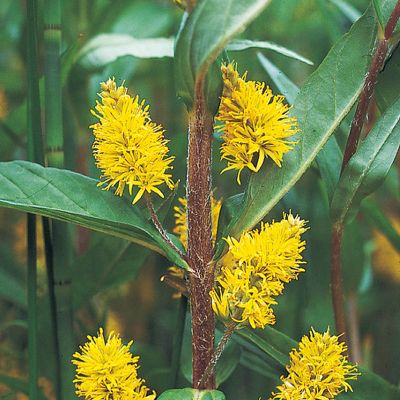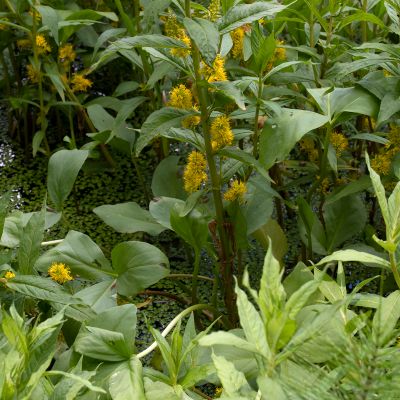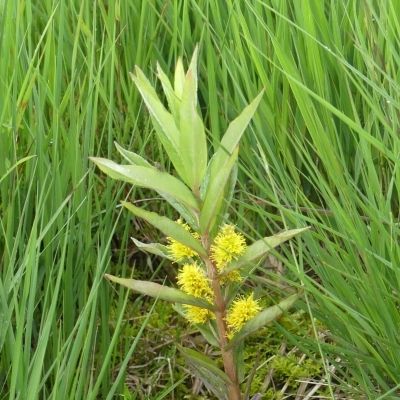Lysimachia thyrsiflora L.
1028110
Species
ISFS : 251700
Checklist : 1028110
ISFS : 251700
Checklist : 1028110
Contains :
Synthesis
Species description (© Flora Helvetica 2018)
30-70 cm hoch, hellbraun behaart. Blätter gegenständig, die unteren schuppenartig, die oberen schmal-lanzettlich, 4-15mal so lang wie breit, am Rand etwas umgerollt, rot punktiert, sitzend. Blüten in dichten, 1,5-2,5 cm langen, gestielten Trauben, diese in den mittleren Blattwinkeln. Krone gelb, bis fast zum Grund geteilt, mit 5 oder 6 linealen, 3-6 mm langen Zipfeln, rot punktiert. Kapsel 3 mm lang.Flowering period (© Flora Helvetica 2018)
5-7Habitat and distribution inside Switzerland (© Flora Helvetica 2018)
Sümpfe, Ufer, Gräben / kollin-montan / M, vereinzelt J und ANEWorld distribution (© Flora Helvetica 2018)
Europäisch-nordamerikanischEcological indicator (© Landolt & al. 2010)
4+w+32-33+3.g.2n=(20)40,54Status
IUCN status
VulnerableNational Priority
4 - weak national priorityInternational responsibility
1 - weakConservation
Threats
Aufgabe der traditionellen Streunutzung
Melioration, Auffüllung, Austrocknung, Entwässerung, Überbauung
Eutrophierung, v. a. aus benachbarten Fettwiesen und Äckern
Verbuschung, Beschattung
Eindringen von Neophyten (z. B. Goldruten), Verschilfung
Sukzession
Tritt (Badende, Picknick-Plätze, Fischer)
Wellenschlag, mechanischer Schaden durch Boote
Ablagerung von Aushubmaterial (z. B. Material von vertieften oder erneuerten Drainagegräben)
Z. T. kleine, isolierte Populationen
Distribution map
Habitat and distribution inside Switzerland
M, vereinzelt J und ANEWorld distribution
Europäisch-nordamerikanischEcology
Life form
Geophyte
Habitats
Milieux Phytosuisse (© Prunier et al. 2017)
Habitats © Delarze & al. 2015
 | 2.2.1.1 - Grossseggenried (Magnocaricion) |
bold
Dominant species, influencing the appearance of the habitat
 Character species
Character species
 Less strictly linked to a specific habitat
Less strictly linked to a specific habitat
Ecological indicator values by © Landolt & al. (2010)
| Soil factors | Climatic factors | Salinity tolerance | |||
|---|---|---|---|---|---|
| Humidity Value H | 4+w+ | Light Value L | 3 | Salinity Index | -- |
| Reaction Value R | 3 | Temperature factor T | 3+ | ||
| Nutriments value N | 2 | Continentality K | 3 | ||
- Ecological values legend
Humidity Value H 1 very dry 1+ dry 2 moderatly dry 2+ moist 3 medium wet 3+ wet 4 very wet 4+ soggy 5 submerged or underwater f plants living in running water u mostly submerged plants v partly submerged, partly floating plants w humidity moderately variable (± scale of 1-2) w+ highly variable humidity (scale exceeding ± 2) Reaction Value R 1 Very acid (pH 2.5-5.5) 2 acid (pH 3.5-6.5) 3 lightly acid to neutral (pH 4.5-7.5) 4 neutral to basic (pH 5.5-8.5) 5 basic (pH 6-5 -> 8.5 Nutriments value N 1 very low in nutrients 2 low in nutriments 3 medium-poor to medium-rich in nutrients 4 rich in nutriments 5 very rich in nutriments Salinity tolerance 1 halotolerant 3 halophyle Light Value L 1 very shady 2 shady 3 lighted areas 4 luminous 5 highly luminous Temperature factor T 1 alpine to nival stages (from the treeline to the snowline) 1+ suprasubalpine and upper subalpine levels (pine and larch forests) 2 subalpine level (coniferous forests without beeches up to the upper limit of spruces) 2+ lower subalpine and upper mountain stages 3 mountain level (beech and silver fir forests, in the central Alps Scots pine forests) 3+ lower mountain and upper hill levels 4 hill level (mixed deciduous oak forests) 4+ hot places, hill level 5 very hot places, hill level (only in the hottest places, typical of southern Europe) Continentality K 1 Atlantic (high air humidity, very low temperature variations, mild winters) 2 Sub-Atlantic (high air humidity, low temperature variations, relatively mild winters) 3 sub-Atlantic to subcontinental (average air humidity, moderately variable temperature, slightly low winter temperatures) 4 subcontinental (low air humidity, large temperature variations, rather cold winters) 5 continental (very low air humidity, very large temperature variations, cold winters)
Water dependency
| Rivers | 1 - Secondary habitat |
| Calm water | 1 - Secondary habitat |
| Ground water | 0 - No link |
Nomenclature
Accepted Name (Checklist 2017)
Lysimachia thyrsiflora L.
Vernacular name
Deutscher Name :
Strauss-GilbweiderichNom français :
Lysimaque à fleurs en épisNome italiano :
Mazza d'oro tirsifloraMatch with other reference books
| Relation | Nom | Book | No |
|---|---|---|---|
| = | Lysimachia thyrsiflora L. | Checklist 2017 | 251700 |
| = | Lysimachia thyrsiflora L. | Flora Helvetica 2001 | 849 |
| = | Lysimachia thyrsiflora L. | Flora Helvetica 2012 | 1380 |
| = | Lysimachia thyrsiflora L. | Flora Helvetica 2018 | 1380 |
| = | Lysimachia thyrsiflora L. | Index synonymique 1996 | 251700 |
| = | Lysimachia thyrsiflora L. | Landolt 1977 | 2335 |
| = | Lysimachia thyrsiflora L. | Landolt 1991 | 1898 |
| = | Lysimachia thyrsiflora L. | SISF/ISFS 2 | 251700 |
| = | Lysimachia thyrsiflora L. | Welten & Sutter 1982 | 1266 |
= The taxon corresponds to the accepted taxon (Checklist 2017)
< The taxon is included in the accepted taxon (Checklist 2017)
> The taxon includes (among others) also the accepted taxon (Checklist 2017)
< The taxon is included in the accepted taxon (Checklist 2017)
> The taxon includes (among others) also the accepted taxon (Checklist 2017)
Status
Native status
-IUCN list of endangered species (© Walter & Gillett 1997) : No
Status on national Red List 2016
IUCN status:
Vulnerable

Additional information
IUCN criteria: A4c
Status on regional Red List 2019
| Biogregraphic regions | Status | IUCN criteria |
|---|---|---|
| Jura (JU) | VU | A4c |
| Mittelland (MP) | VU | A4c |
| Alpennordflanke (NA) | VU | A4c |
| Alpensüdflanke (SA) | -- | |
| Östliche Zentralalpen (EA) | -- | |
| Westliche Zentralalpen (WA) | -- |
- Legend
EX Extinct RE Regionally Extinct CR(PE) Critically Endangered, Probably Extinct CR Critically Endangered EN Endangered VU Vulnerable NT Near Threatened LC Least Concern DD Data Deficient NE Not Evaluated NA Not Applicable
National Priority Species List Status
| National Priority | 4 - weak national priority |
| Need to take action | 2 - |
| International responsibility | 1 - weak |
| Need to monitor populations | 2 - |
Protection status
| International (Bern Convention) | No | |
| TG | total protection | (01.01.2018) |
| Switzerland | -- | |
| VD | total protection | (02.03.2005) |
- Disclaimer
InfoFlora compiles information on protected species as accurately as possible, taking it from the respective cantonal laws. In some cases, however, it was not possible to use the plant names as listed in the original text, but an interpretation of their taxonomy or nomenclature was necessary. The exact meaning of the categories „completely protected“ and „partially protected“ differs among the cantons.
InfoFlora cannot guarantee that the information on the protection status is correct and complete. In case of doubts, we recommend to look up the texts of the respective cantonal law.
Status by sector of activity
| Agriculture-related environmental objectives : | Z - | more informations |
| Forest management environmental objectives : | more informations |
Conservation
Threats and measures
Aufgabe der traditionellen Streunutzung
Bewirtschaftungsbeiträge
Weiterführung traditioneller Nutzung
Melioration, Auffüllung, Austrocknung, Entwässerung, Überbauung
Keine Entwässerungen in der Umgebung
Schutzzonen (Mikroreservate) schaffen
Rücksichtnahme auf die Fundstellen
Eutrophierung, v. a. aus benachbarten Fettwiesen und Äckern
Einrichtung oder an einigen Fundstellen Vergrösserung von Pufferzonen, darin keine Düngung
Massnahmen gegen Eutrophierung aus der Luft und durch Seewasser (Überschwemmungen) weiterführen
Verbuschung, Beschattung
Regelmässig entbuschen wo nötig
gezielt auslichten
Eindringen von Neophyten (z. B. Goldruten), Verschilfung
Neophyten und Verschilfung früh bekämpfen
Sukzession
Mähbare Bereiche regelmässig im Spätsommer schneiden
Streue entfernen
kleinere Teiche mittelfristig teils ausbaggern
Tritt (Badende, Picknick-Plätze, Fischer)
Bessere Besucherlenkung an einigen Stellen
kritische Bereiche durch Hindernisse sperren
Hinweistafeln
Wellenschlag, mechanischer Schaden durch Boote
Röhricht sofern nötig (v. a. Sempachersee) z. B. durch vorgelagerte Maschendrahtzäune vor Schaden bewahren
Ablagerung von Aushubmaterial (z. B. Material von vertieften oder erneuerten Drainagegräben)
Keine Ablagerungen in wertvollen Lebensräumen
Z. T. kleine, isolierte Populationen
Schutz aller Fundstellen
regelmässige Bestandeskontrollen
Erfolgskontrolle der Massnahmen gewährleisten



